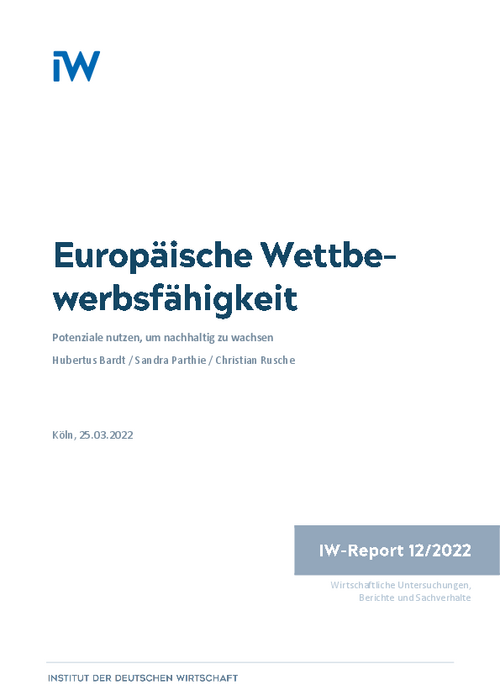The EU's position as a major global economic power is increasingly under threat. On the one hand, this is a consequence of the crises that the EU has faced in the last two decades. In particular, these include the global financial crisis (2007-2009), the euro crisis (2010-2012), the refugee crisis (2015-2016), Brexit (2016-2020), the Corona pandemic since 2020 and the war in Ukraine from 2022.

European competitiveness: Exploiting potential for sustainable growth

The EU's position as a major global economic power is increasingly under threat. On the one hand, this is a consequence of the crises that the EU has faced in the last two decades. In particular, these include the global financial crisis (2007-2009), the euro crisis (2010-2012), the refugee crisis (2015-2016), Brexit (2016-2020), the Corona pandemic since 2020 and the war in Ukraine from 2022.
On the other hand, however, global competitors, above all the USA and China, have also been able to distance themselves from the EU regarding a number of relevant competitive factors. In other words, the EU's share of global GDP has fallen in recent years because other countries have grown faster. The USA, even with its smaller population than the EU, has a larger share of global economic output. The People's Republic of China has been steadily catching up in terms of per capita economic output since 1999. It started at around eight percent of the U.S. level and was at around 27 percent in 2020.
These observations are complemented by a comparative analysis of private household consumption expenditure, which has grown significantly faster in the USA and China than in the EU. It would appear, therefore, that significantly less is being invested in the EU than in these other regions of the world. This raises the question of the EU's locational quality and how it can better position itself in the international competition for investment.
The relevant indicators in assessing the EU's competitiveness are the quality of government structures and infrastructures, available knowledge, access to natural and financial resources, cost structures and market size and purchasing power. The analytical focus of this paper is on industry, which is of particular importance for economic development in Europe and the investment dynamics of the European economies. The IW Location Index, which looks at the industrial location quality for 45 industrialized and emerging economies, clearly shows that the USA is overall the more attractive investment location for industry compared with Europe. Especially the gap in the availability of natural and financial resources is above average. Access to cheap raw materials and energy sources is an important location factor for the USA that is difficult to catch up with, but Europe's chronic lag in corporate financing could be remedied and its human resources improved.
The EU Commission's International Digital Economy and Society Index (I-DESI) paints a similar picture. In the five factors examined, connectivity, digital skills, internet use, digital technology and public digital services, the EU performs significantly worse on average than the USA and is only just ahead of China.
In order to catch up with the world leaders in the industrial sector, but also in the mastery of important digital key technologies, a study by the European Parliamentary Research Service (2019) concludes that the completion of the EU internal market alone promises an additional potential of 713 billion euros or almost five percent of the EU gross domestic product (GDP) of 2017. Overall, there is potential of up to 2.2 trillion Euros or around 14 percent of GDP. In view of the below-average development of the economic performance of the EU27 countries compared with the USA and the world, it is essential that this potential and the expansion of the digital single market in particular be exploited. Access to natural raw materials remains a fundamental disadvantage of the EU and is becoming increasingly difficult, also against the backdrop of the Ukraine war. Here, the EU and its member states must take action as a matter of priority, reduce strategic, one-sided interdependencies and support diversification opportunities for companies.

European competitiveness: Exploiting potential for sustainable growth

More on the topic
Not so Different?: Dependency of the German and Italian Industry on China Intermediate Inputs
On average the German and Italian industry display a very similar intermediate input dependence on China, whether accounting for domestic inputs or not.
IW
China’s Trade Surplus – Implications for the World and for Europe
China’s merchandise trade surplus has reached an all-time high and is likely to rise further. A key driver appears to be a policy push to further bolster Chinese domestic manufacturing production, implying the danger of significant overcapacities.
IW